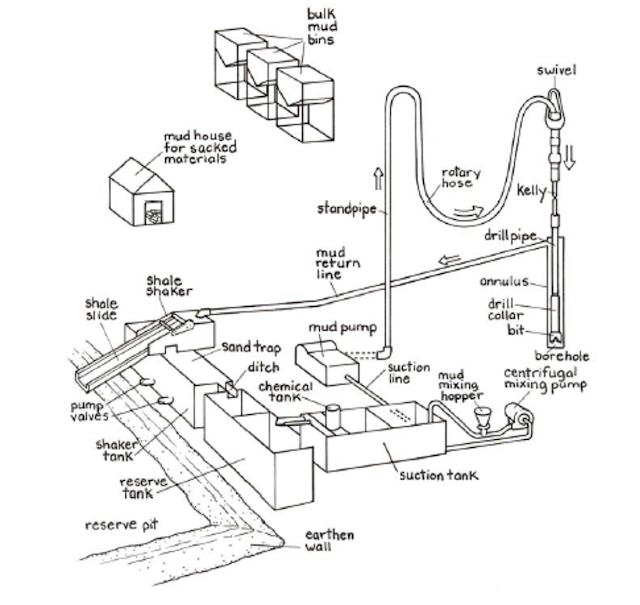Mud circulation system:
Mud circulation system:
Mud
circulating system developed during the end of 1940s, after high pressure pumps
and jet bits became available. Modern mud system is a combination of various
systems all for the purpose of circulating mud and to clean it.
Mud Circulating System Components:
·
Mud return line
A trough
or pipe, placed between the surface connections at the well bore and the shale
shaker.
·
shale shaker
A
series of trays with sieves or screens that vibrate to remove cuttings from
circulating fluid; openings size are selected to match the size of the solids
expected.
·
Desander
A
centrifugal device for removing sand from; It may be operated mechanically or
by a fast-moving stream of fluid inside a special cone-shaped vessel, in which
case it is sometimes called a hydrocyclone.
·
Desilter
A
centrifugal device, similar to a desander, used to remove very fine particles,
or silt. To keeps the amount of solids in the fluid to the lowest possible
level.
·
Degaser
The
equipment used to remove unwanted gas from a liquid, especially from drilling
fluid.
·
Mud-Gas Separator
A
device that remove gas from the mud coming out of a well when a kick is being
circulated out.
·
Mud Tanks
(pits)
A
series of open tanks usually made of steel plates, through which the drilling
mud is cycled . Additives are mixed with the mud in the pit, and well . They
are also called shaker pits, and suction pits, depending on their main purpose.
·
Mud Pumps
A
large reciprocating pump used to circulate mud on a drilling rig.
·
Chock Manifold
The
arrangement of piping and special valves, called chokes, through which drilling
mud is circulated when the blowout preventers are closed to control the
pressures encountered during a kick.
·
Mud gun
Is typically used
to mix the mud mixture in the rig tanks (see Figure).
This is done to maintain a homogenous mix and ensure an
even distribution of mud components. In carrying out this function, the outlet
pressure can become high enough that the gun might become unmanageable by
workers.
Mud Circulating Systems:
Circulation
of drilling mud begins from the mud pits, with suction lines leading to the mud
pumps (figures). Mud pumps send the mud through the rotary hose into the
swivel, down through the drill stem, and out through the bit. The mud returns
to the surface through the annulus of the borehole, then through the mud return
line back into the mud pits. The mud is made up and conditioned in the surface
system, using various materials and auxiliary equipment.
The
mud pump is the primary component of any system using a liquid as the
circulating fluid. It furnishes the pressure for sending the fluid through the
system. The swivel permits the drill stem to be raised or lowered while
circulating and rotating. The drill stem, made up of Kelly, drill pipe, and
drill collars, rotates the bit, furnishes weight for drilling, and provides the
con dui through which fluid flows to the bit. Drilling fluid passes through the
bit, out the nozzles, and up through the annulus, which is the space between
the drill stem and the wall of the well. Fluid returning to the surface through
the annulus carries with it the cuttings made by the bit. When the fluid
reaches the surface, it flows into the mud pits through a mud return line,
after having rock cuttings, sand, and shale separated from it by devices such
as shale shakers, desanders, desilters, and centrifuges.
A
system for pumping drilling mud typically operates at high pressure of up to
34,000 kilopascals (4,930 pounds/square inch). To ensure that a component of
the system does not fail, all parts of the system must be rated at least equal
to the maximum working pressure of the pump. This is also known as the
“allowable rated working pressure”.
Typically, this is shown on a metal plate
affixed to the pump.
Mud circulation system:
 Reviewed by mohammed omar oun
on
November 27, 2019
Rating:
Reviewed by mohammed omar oun
on
November 27, 2019
Rating:
 Reviewed by mohammed omar oun
on
November 27, 2019
Rating:
Reviewed by mohammed omar oun
on
November 27, 2019
Rating:

















No comments: